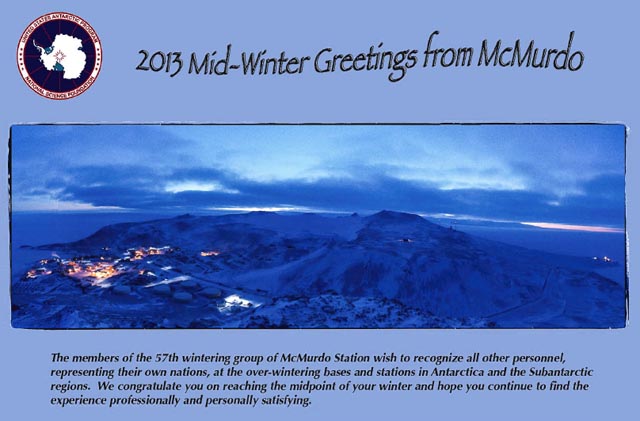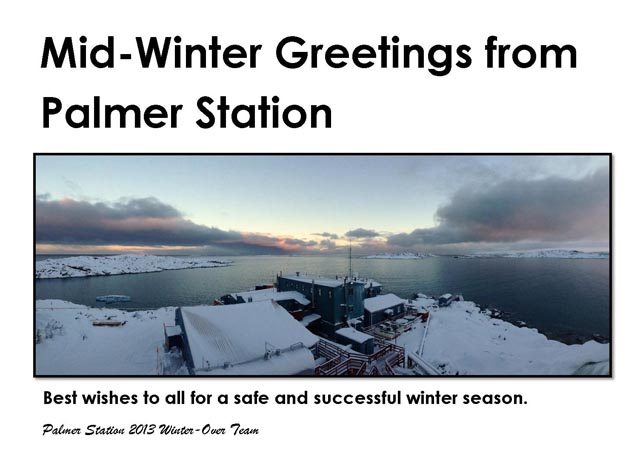|
Midwinter Day 2013U.S. research stations observe unique Antarctic holidayPosted June 21, 2013
Spending a winter in Antarctica is often compared to a marathon — slow and steady wins the race back to summer and sunlight. Scientists and support personnel at the U.S. Antarctic Program’s Celebrations take place at the stations of many nations that have a presence on the continent. It marks the point when the sun begins its return back south. It is a tradition that has for more than 50 years has been recognized by the President of the United States. Dwight D. Eisenhower began the custom of sending an official greeting to the Antarctic stations on Midwinter’s Day. President Barack Obama “In Antarctica, the drive to study and explore has generated groundbreaking insights into Earth’s atmosphere, oceans and ecosystems, and has shed light on the complex processes determining our climate,” he wrote. “As you conduct your research during harsh winter nights, may your talents continue to make the world better for all of us.” For McMurdo and South Pole The first Midwinter’s Day was celebrated in 1898 by the crew of the Belgica, a Belgian vessel that became stuck in pack ice and was forced to overwinter until it finally broke free in February 1899. Unprepared to spend a winter in Antarctica, many of the crew suffered from scurvy, which was only alleviated after the men began to eat seal and penguin meat that provided essential vitamins. Midwinter feast fare has improved since then. For instance, famed polar explorer Capt. Robert Falcon Scott lauded the 1902 midwinter dinner in his journal. The menu included turtle soup, mutton and plum pudding. Today’s midwinter celebrations are perhaps more appetizing to today’s palate. More than 50 people at Palmer Station, which includes researchers and crew from the research vessel Laurence M. Gould currently in port, will enjoy roast pork and peach cobbler, among other dishes. “Taking a brief break from the many ongoing science and construction projects, the station and vessel plan to celebrate the arrival of midwinter with an evening of good food and great camaraderie,” said Bob DeValentino, Palmer Station winter site manager. McMurdo Station’s 141 residents will hold their midwinter dinner on June 22 with a travel motif. “The idea behind this theme is to celebrate the intrepid spirit of winterovers and recognize that many of [us] are brought here through a desire to travel the world,” said McMurdo Station winterover Meghan Brown. Planning of the midwinter celebration by volunteers began in May, with various committees organizing events, invitations and decorations. About 20 people participated in a one-mile midwinter run around the station earlier in the week. Nearly 30 people were invited to a special meal at New Zealand’s Scott Base The 44 South Pole Station winter-overs endure the longest period of isolation, with the facility inaccessible from mid-February to at least late October. It’s no wonder that one of the midwinter South Pole traditions is to watch “The Shining,” a movie about a hotel caretaker driven mad during his own winter isolation. Midwinter dinner will actually be held on Saturday, June 22, preceded by a scary movie marathon for off-duty personnel. Another movie marathon will follow on Sunday. “So, lots of movie watching and probably some impromptu stuff,” said Weeks Heist, South Pole winter site manager. Another Midwinter Day tradition — once accomplished by ham radio but now conducted via e-mail — is the exchange of greetings between about 40 winterover crews scattered across the Antarctic. Most messages include a picture of the station crew, the facility itself or a scenic Antarctic shot, along with a brief note wishing fellow winterovers a happy and healthy season. |



For USAP Participants |
For The Public |
For Researchers and EducatorsContact UsU.S. National Science FoundationOffice of Polar Programs Geosciences Directorate 2415 Eisenhower Avenue, Suite W7100 Alexandria, VA 22314 Sign up for the NSF Office of Polar Programs newsletter and events. Feedback Form |




